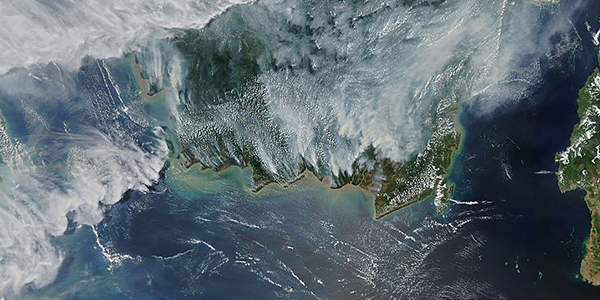Seasonality and Human Agency in the Anthropocene
PhD student Andrew Gibson discusses a recent LCAB research forum led by Dr Felicia Liu, a lecturer in sustainability in the Department of Environment and Geography at the University of York.

Dr Liu delivered a fascinating presentation detailing her work ‘Seasons of the Anthropocene’, which examines the societal response to an entirely novel ‘haze season’, caused by the deliberate burning of tropical peatlands. Since around the turn of the millennium, haze season has become established as a recurrent feature of the calendar across a large swathe of the Southeast Asia region.
After the forum, I found myself thinking about Gilbert White, whose major work: ‘The Natural History and Antiquities of Selborne’, first published in 1789, meticulously documents the timings of a wide variety of seasonal phenomena from flowers blooming to birds migrating. In White’s day, the passage of the seasons was perceived to be one of the immutable tenets of reality. Any disruption to this was seen as an affront to the natural order and was thus profoundly disturbing to society in general. This is evident in his own account of a one-off ‘haze season’ in 1783, which we now know to have been caused by a volcanic eruption in Iceland, and about which White writes:
‘The summer of the year 1783 was an amazing and portentous one, and full of horrible phenomena; for besides the alarming meteors and tremendous thunderstorms that affrighted and distressed the different counties of this kingdom, the peculiar haze, or smoky fog, that prevailed for many weeks in this island, and in every part of Europe, and even beyond its limits, was a most extraordinary appearance, unlike anything known within the memory of man… The sun, at noon, looked as blank as a clouded moon, and shed a rust-coloured ferruginous light on the ground, and floors of rooms; but was particularly lurid and blood-coloured at rising and setting… The country people began to look with a superstitious awe at the red, lowering aspect of the sun; and indeed there was reason for the most enlightened person to be apprehensive’ .
While the haze of 1783 was, in a sense, fundamentally different from the haze season in Southeast Asia as it was the product of geological rather than anthropogenic forces, its cultural construction as a product of ‘forces beyond our control’ is surprisingly similar. Further analysis by Dr Liu and colleagues reveals that, with the notable exception of third sector stakeholders, the main governmental and private sector actors who collectively perpetuate the haze season do anything but accept responsibility for its existence. Rather, they seek to divert attention, normalise, and in some cases even capitalise on the situation. In doing so, they perform the extraordinarily self-defeating act of denying their own agency.
This exemplifies what is perhaps the most urgent and intriguing contradiction at the heart of the early Anthropocene. The human species may have effectively assumed control over the forces of nature, but in spite of our unprecedented cognitive abilities, we have done so in a manner completely lacking in forethought and intention. Nobody ever ‘decided’ to instigate a novel haze season in Southeast Asia, any more than they decided to increase atmospheric CO2 to dangerous levels. To paraphrase White, as we unwittingly sweep away the natural order: indeed there is reason for the most enlightened person to be apprehensive.
Yet, as I explore in my own work (forthcoming – I am currently in week 2 of my PhD research!) this often-wilful lack of global intention is likely to comprise only a transient phase in the human cognitive timeline. The global perspective from which our own self-defeating behaviours are so readily apparent is a by-product of the knowledge and machinery that enabled us to become a force of nature in the first place. During Gilbert White’s day, and in much of the time that has elapsed since, we simply had no idea of what we were doing to our planet. I would encourage anyone concerned by our current trajectory to take heart from the fact that this global perspective is still very much a work-in-progress. Research such as Dr Liu’s, which beautifully illustrates what it means to reside in the early Anthropocene, is an indispensable part of this effort.
1 Excerpt from Gilbert White’s ‘The Natural History and Antiquities of Selborne’, Letter 65